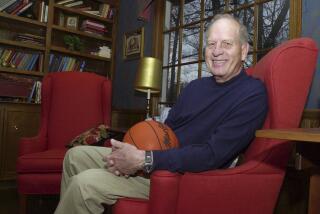Frank K. Everest Jr., 84; Fighter and Test Pilot Was ‘Fastest Man Alive’ in ‘50s
- Share via
Brig. Gen. Frank Kendall Everest Jr., a fighter pilot and legendary test pilot who for a time during the 1950s held the title “fastest man alive,” has died. He was 84.
Everest died Oct. 1 in Tucson. The cause of death was not reported.
Everest flew what at the time were the nation’s most advanced aircraft, including the X-1, X-2, X-3, X-4, X-5, XF-92 and YB-52. He also participated in test programs for the F-100, F-101, F-102, F-104, F-105, B-52, B-57 and B-66.
He became the “fastest man alive” in 1956 when he piloted the Bell X-2 at more than 1,900 mph, or Mach 2.9, surpassing the record set by Chuck Yeager in an X-1A three years earlier. The experience prompted Everest to write the book “The Fastest Man Alive” with John Guenther. It was published in 1958.
Everest entered the U.S. Army Air Forces pilot training program in November 1941 and was commissioned the following July. Everest flew 94 combat missions in Africa, Sicily and Italy, shooting down two German aircraft. Later, as a squadron commander in China, he completed 67 missions and destroyed four Japanese aircraft before his plane was brought down in May 1945. He spent the remainder of the war as a prisoner of war.
After the war, Everest was assigned to the Air Force’s Flight Test Center at Edwards Air Force Base and became the chief Air Force test pilot as head of the Flight Test Operations Division.
He set two other speed records, in 1949 in a Bell X-1 experimental rocket plane and in 1953 in an F-100, before flying the X-2 on July 23, 1956.
His military honors include the Legion of Merit with oak leaf cluster and the Distinguished Flying Cross with two leaf clusters.
Everest retired from the Air Force in 1973 and worked as a test pilot with Sikorsky Aircraft. He and his wife retired in Arizona in 1983.
Everest was born Aug. 10, 1920, in Fairmont, W. Va., and became interested in flying at age 8 when he watched “in wide-eyed wonder” when an early barnstorming pilot, “Skyland Scottie,” brought his flying circus to his hometown. “I loved the speed, and I loved the air,” he wrote in an article published Dec. 4, 1955, in the Los Angeles Times.
He attended Fairmont State College and later studied engineering at West Virginia University.
Both he and Yeager, the first man to break the sound barrier, were inductees into the National Aviation Hall of Fame in Dayton, Ohio, on July 21, 1989.
In 1991, Everest was among five test pilots, including Neil Armstrong, the first man to walk on the moon, to be inducted into the Aerospace Walk of Honor in Lancaster, Calif. Like the other honorees who had also flown out of Edwards Air Force Base in the 1950s and ‘60s, Everest is represented in the Walk of Honor by a 6-foot granite monument.
He is survived by two daughters, four grandchildren and five great-grandchildren.


